6英语词汇学第六章_同义反义上下义汇总
- 格式:ppt
- 大小:438.00 KB
- 文档页数:47
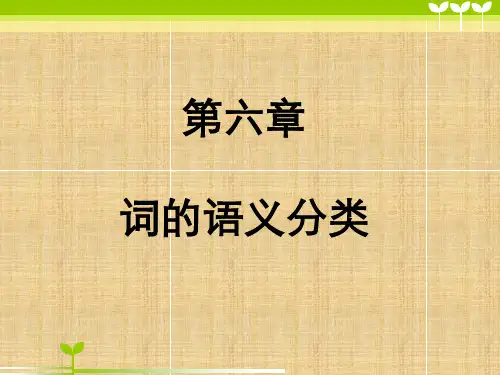
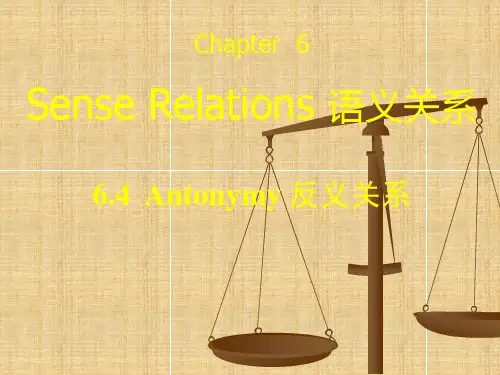

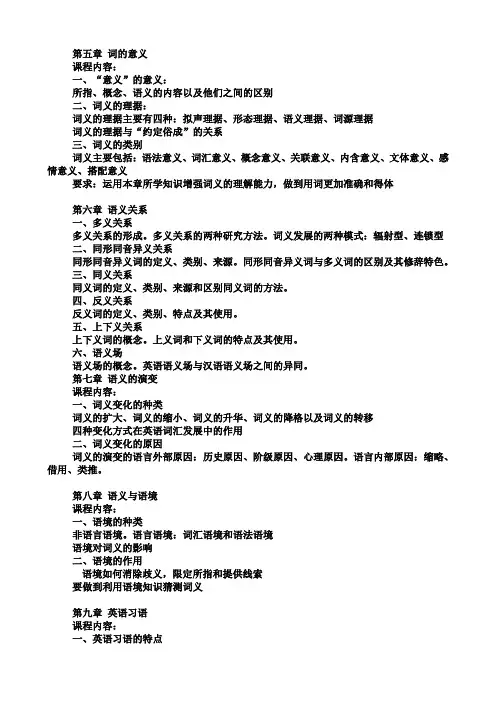
第五章词的意义课程内容:一、“意义”的意义:所指、概念、语义的内容以及他们之间的区别二、词义的理据:词义的理据主要有四种:拟声理据、形态理据、语义理据、词源理据词义的理据与“约定俗成”的关系三、词义的类别词义主要包括:语法意义、词汇意义、概念意义、关联意义、内含意义、文体意义、感情意义、搭配意义要求:运用本章所学知识增强词义的理解能力,做到用词更加准确和得体第六章语义关系一、多义关系多义关系的形成。
多义关系的两种研究方法。
词义发展的两种模式:辐射型、连锁型二、同形同音异义关系同形同音异义词的定义、类别、来源。
同形同音异义词与多义词的区别及其修辞特色。
三、同义关系同义词的定义、类别、来源和区别同义词的方法。
四、反义关系反义词的定义、类别、特点及其使用。
五、上下义关系上下义词的概念。
上义词和下义词的特点及其使用。
六、语义场语义场的概念。
英语语义场与汉语语义场之间的异同。
第七章语义的演变课程内容:一、词义变化的种类词义的扩大、词义的缩小、词义的升华、词义的降格以及词义的转移四种变化方式在英语词汇发展中的作用二、词义变化的原因词义的演变的语言外部原因:历史原因、阶级原因、心理原因。
语言内部原因:缩略、借用、类推。
第八章语义与语境课程内容:一、语境的种类非语言语境。
语言语境:词汇语境和语法语境语境对词义的影响二、语境的作用语境如何消除歧义,限定所指和提供线索要做到利用语境知识猜测词义第九章英语习语课程内容:一、英语习语的特点英语习语的特点可概括为两点:语义的整体性和结构的稳定性二、英语习语的分类英语习语有不同的分类原则,根据习语的语法功能可分为名词性习语、形容词性习语、动词性习语、副词性习语和句式习语三、英语习语的使用习语的文体色彩;修辞色彩,包括各种修辞格;习语的变异形式。
注意收集习语,并分析它们的构成形式、语法功能和修辞特色。
第十章英语词典一、词典的种类单语词典与双语词典;语文词典与百科词典;大型词典、案头词典和袖珍词典;专用词典。

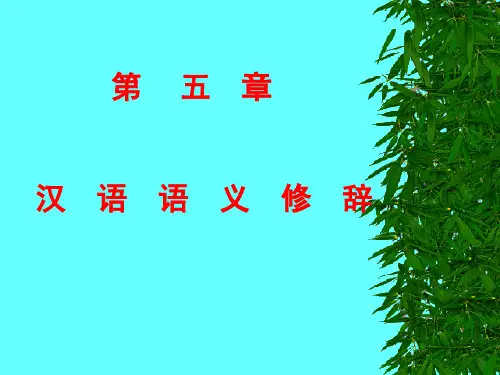
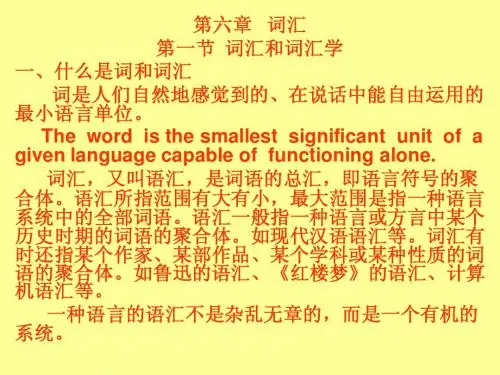

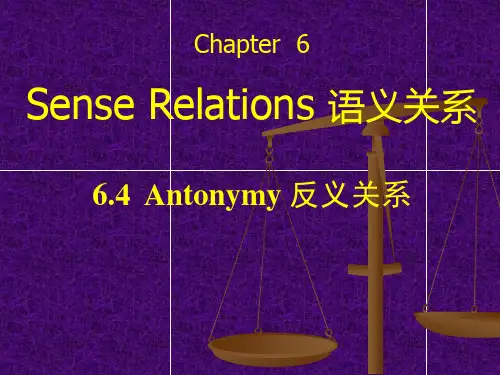
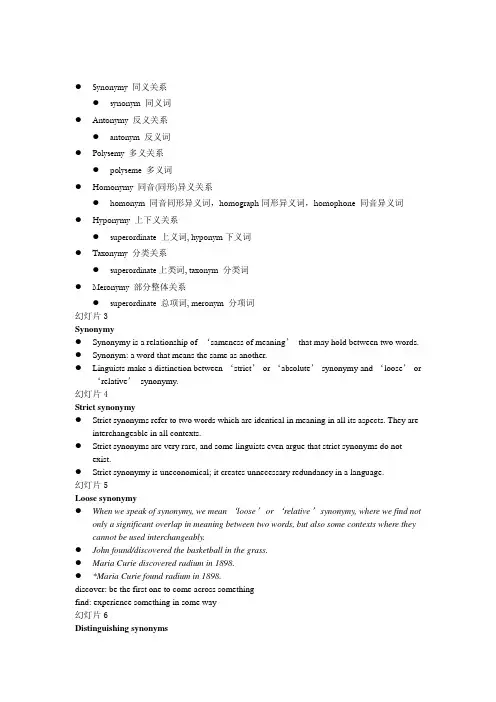
●Synonymy 同义关系●synonym 同义词●Antonymy 反义关系●antonym 反义词●Polysemy 多义关系●polyseme 多义词●Homonymy 同音(同形)异义关系●homonym 同音同形异义词,homograph同形异义词,homophone 同音异义词●Hyponymy 上下义关系●superordinate 上义词, hyponym下义词●Taxonymy 分类关系●superordinate上类词, taxonym 分类词●Meronymy 部分整体关系●superordinate 总项词, meronym 分项词幻灯片3Synonymy●Synonymy is a relationship of ‘sameness of meaning’that may hold between two words.●Synonym: a word that means the same as another.●Linguists make a distinction between ‘strict’or ‘absolute’synonymy and ‘loose’or‘relative’synonymy.幻灯片4Strict synonymy●Strict synonyms refer to two words which are identical in meaning in all its aspects. They areinterchangeable in all contexts.●Strict synonyms are very rare, and some linguists even argue that strict synonyms do notexist.●Strict synonymy is uneconomical; it creates unnecessary redundancy in a language.幻灯片5Loose synonymy●When we speak of synonymy, we mean ‘loose’or ‘relative’synonymy, where we find notonly a significant overlap in meaning between two words, but also some contexts where they cannot be used interchangeably.●John found/discovered the basketball in the grass.●Maria Curie discovered radium in 1898.●*Maria Curie found radium in 1898.discover: be the first one to come across somethingfind: experience something in some way幻灯片6Distinguishing synonyms●We often take the following things into consideration when we try to find the differencesbetween synonyms.●Different English dialects●Different stylistic meanings●Different connotative meanings幻灯片7Synonyms from different dialects●Some synonym pairs differ in that they belong to different dialects of English. Here are someexamples of synonyms from British and American English:BrE AmE BrE AmElift elevator farm ranchlawyer attorney biscuit cookierubbish garbage pavement sidewalk幻灯片8Synonyms with different stylistic meanings●One of a pair of synonyms may be used in a more formal context than the other. Here aresome examples of synonym pairs.Informal Formal Informal Formaldie decease daddy fatherblame chide guy manwest occidental praise eulogy幻灯片9Synonyms with different connotative meanings●Synonyms may have different emotive associations (connotative meanings).famous notorious(disreputably) misuse abuse(of privilege orpower)ambiguous equivocal(deliberately) new novel(strikingly)hate loathe(with disgust) obtain procure(with effort)幻灯片10Source of synonyms●Why are there so many synonyms in English?●The primary reason for this has to do with the heavy borrowing from other languages,especially from French and Latin.English French Latinask question interrogatetime age epochbegin commencebuy purchase幻灯片11Antonymy (反义关系)●Antonymy is a relationship of ‘meaning opposition’ that may hold between twowords.●Antonyms can be defined as words which are opposite in meaning.●Major types of antonyms:●Gradable antonyms●Contradictory or complementary antonyms●Converse antonyms幻灯片12Gradable antonyms●Gradable antonyms include pairs like the following:●beautiful ugly●expensive cheap●fast slow●hot cold●long short●rich poor●wide narrowThese pairs are called gradable antonyms because they do not represent a more/less relation. The words can be the end-points of a continuum (连续体).Since they are gradable, they allow comparison.幻灯片13Contradictory (complementary) antonyms●Contradictory antonyms include pairs like the following:●asleep awake●dead alive●on off●remember forget●win lose●true falseThese pairs are called contradictory antonyms because they represent an either/or relation.If you permit some behavior, then it is not forbidden.Since they are not gradable, they do not allow comparison.幻灯片14Converse antonyms (逆行)●The following are examples of converse antonyms:●lend borrow●husband wife●above below●before after●behind in front of●buy sell●give receive●parent child●speak listenLend is the converse of borrow and vice versa; i.e. the substitution of one member for the other does not change the meaning of a sentence if it is accompanied by the change of subject and object.John lent Mary five dollars.=Mary borrowed five dollars from John.幻灯片15Contradictory antonyms vs. Converse antonyms1,The bridge is above the river.The river is below the bridge. Converse antonyms are relational antonyms.2,This behavior is allowed.This behavior is not prohibited. Contradictory antonyms are either/or antonyms.幻灯片16Polysemy●When a word is first coined, it is always the case (true) that it has only one meaning(monosemic). But in the course of development, the same symbol may be used to express new meanings. The result is polysemy.●Polysemy shows the economy and efficiency of human languages.幻灯片17Two processes leading to polysemy●There are two important processes in the development of meaning:●Radiation (发散)●Concatenation(串联)幻灯片18Radiation●Radiation is a process in which the primary meaning stands in the center, and the derivedmeanings radiate from it in every direction like rays.●All the derived meanings can be traced back to the primary meaning.幻灯片19Radiation Example: faceWe can get the derived meanings by extension, narrowing, analogy, transfer, etc.the front of the head(Primary Meaning): 1a person,2self-respect,3outward appearance,4the surface of a thing,5countenance(Derived Meaning)幻灯片20Concatenation●Concatenation is a process in which the meaning of a word moves gradually from its primarymeaning by successive shifts, like the links of a chain, until there is no connection between the meaning that is finally developed and the primary meaning.●Unlike radiation where each of the derived meaning is directly related to the primarymeaning, concatenation is a process where each of the later meaning is related only to the preceding one.1→2→3→4→5→6幻灯片21Concatenation Example: candidateA a person dressed in whiteA+B(bridging context) a white robed applicant for office (because the Romans wore white robes when standing for office)B a person taking an examinationThere is no connection between A and B, because the middle link (A+B) has vanished.The primary meaning A has also vanished. Now the derived meaning has become the central meaning.幻灯片22Homonymy●Homonymy is the relation between two words that are spelled or pronounced in the sameway but differ in meaning.●Such words are called homonyms.●lie vi. / lie vi. -- perfect homonyms●tear n./ tear vt.--homographs●coarse/course --homophones幻灯片23Perfect homonyms●Perfect homonyms: words identical in both sound and spelling, but different in meaning●bank: n./ bank: n.●bear: n./ bear: vt.幻灯片24Homographs●Homographs: words identical only in spelling but different in sound and meaning.●bow: vi. to bend one’s head as a greeting●bow: n. the device used for shooting arrows●sow: n. female pig●sow: vi. to scatter seeds●perfect: v. /- ’-/●perfect: adj. /’- -/幻灯片25Homophones●Homophones: words identical only in sound but different in spelling and meaning.●sun/son●deer/dear●right/write●pair/pear●stationary/stationery幻灯片26Differentiation of perfect homonyms from polysemous wordsthe same lexeme which has several different meaningsperfect homonymshaving different sourcespolysemous wordsdeveloped from the same sourcedifferent lexemes which have the same form幻灯片27The use of polysemy and homonymy●Polysemous words and homonyms are often used as puns, to achieve certain literary effect,such as humor, irony, etc.●Lewis Carroll’s Alice’s Adventure in Wonderland●“How is bread made?”●“I know that!”Alice cried eagerly. “You take some flour.”●“Where do you pick the flower?”the White Queen asked. “In a garden, or in the hedges?”●“Well, it isn’t picked at all,”Alice explained: “it’s ground.”●“How many acres of ground?”said the White Queen.幻灯片28Hyponymy●Hyponymy is the sense relationship that relates words hierarchically. The underlyingobservation is that some words have a more general meaning, while others have a morespecific meaning, while referring to the same entity.We are not going to have any food today.We are not going to have any vegetables today.幻灯片29FOOD have a more general meaning(superordinate): FRUIT, MEAT, VEGETABLE(They are subordinate terms. They are hyponyms of the superordinate term FOOD.)MEAT: BEEF, PORK, MUTTON(They are subordinate terms. They are hyponyms of the superordinate term MEA T.)VEGETABLE have a more specific meaning:(CABBAGE,CELERY,SPINACH)FRUIT: APPLE, PEACH, ORANGE(Reading from the bottom of the hierarchy, ORANGE is a ‘kind of’ fruit, which is a kind of food.)幻灯片30Taxonymy●Taxonymy is the relationship in which “X is a kind of Y”(Cruse 1986).●Not all hyponyms are good taxonyms.●Hyponyms large spoon, deep spoon are not “a kind of spoon”●Taxonyms teaspoon, soup spoon are “a kind of spoon”幻灯片31Taxonymy - Focal orientation●Focal orientation: this is a perspective that the taxonym and superordinateterm must share so that the relationship works● A blonde is not a kind of woman because blonde has a hair color focalorientation that woman lacks.幻灯片32Taxonymy –distinctive feature●It appears that a taxonym must engage with the meaning of its superordinate ina particular way, by further specifying what is distinctive about it. (p.121)● A strawberry blonde is a type of blonde.●(Distinctive f. of blonde: fair hair)●?A blonde is a type of woman.●(Distinctive f. of woman: sex)●?A stallion is a type of horse.●(Distinctive f. of stallion: sex)幻灯片33Hierarchical characteristic of Taxonymy●Pine is a kind of conifer, which is a kind of tree, which is a kind of plant.幻灯片34Taxonymy vs HyponymyHyponymy分类关系具有严格的层次性,一般不超过五层,每个层次的词项必须严格地遵守同一分类标准;而上下义关系中的词项虽然也能够划分层次,但没有严密的定义标准,对层次的数目也没有规定。
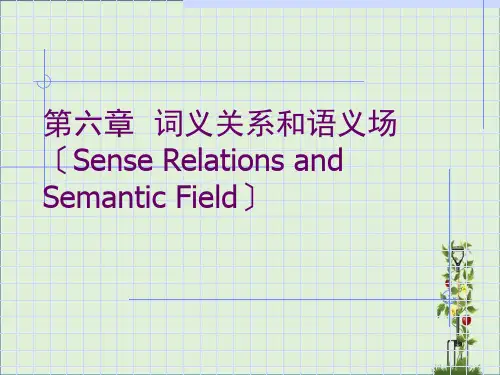
理论教学教案(总第 13- 14学时)项目名称第六章词的语义分类授课学时2任务名称理解词的语义分类教学目标1. 词与词的上下义关系2. 词与词的同义关系3.词与词的反义关系4. 词与词的同形或同音异义关系教学重点词与词的上下义关系教学难点词与词的同义反义关系教学资源PPT教学过程设计教学内容时间分配教学活动设计Step1: 引入复习上一次学习内容Step2: 新课讲授-词的语义分类l.词与词之间的上下义关系概念:语义场 Semantic field类概念(genus)种概念(species)探讨词所表达的类概念与词所表达的种概念之间的关系。
词可以在一个共同的概念下的支配下结合在一起形成语义场。
上下义关系或语义内包指表示个别类概念的词内包在表示一般概念的词中。
关系:互为依存2.词与词之间的同义关系概念:词与词可以因表达同一的逻辑概念而结合在一起,这些词称之为同义词。
特点:1. 同义词意义相同,但形位结构,音位形状和用法不同。
2. 一对一组同义词并不是一成不变的,一个词可以和一部分词构成同义词,也可与另外一部分词构成同义词。
如:look: see; watch; observe seem; appear.同义词之间的差异1. 语义上的差异eg: A teacher was amazed to find that a lazy student had gained a mark of 100 in an important testamaze:难以相信astound:难以相信的程度更高。
escape: flee: 紧急情况下的仓促逃跑2. 感情色彩和语体色彩上的差异感情色彩上:高雅(elevated)、中性(neutral)、粗俗(Vulgar)单词————感情色彩——使用场合horse———中性——----一切场合charger/steed——---高雅——-----诗歌小说plug/nag-----粗俗—-----—口语3. 词与词之间的反义关系词与词之间存在着相反或对立的语义关系——反义关系(antonymy).词义相反或对立的词叫做反义词(antonyms)1. 以词根和派生为依据所形成的的反义关系Clear——vague Large—— smallUp——down (词根反义词)Pleasant ——unpleasantPolite —— impoliteHonest —— dishonest(派生反义词)作业布置复习所学内容授课日期及授课地点明德楼205 第8周下午67节课后反思词与词的上下义关系稍难理解,建议增加案例讲解。